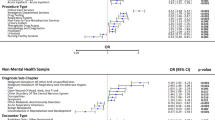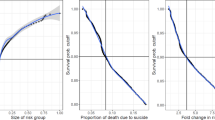Abstract
Motivated by the pressing need for suicide prevention through improving behavioral healthcare, we use medical claims data to study the risk of subsequent suicide attempts (SA) for patients who were hospitalized due to suicide attempts and later discharged. Understanding the risk behaviors of such patients at elevated suicide risk is an important step towards the goal of “Zero Suicide”. An immediate and unconventional challenge is that the identification of SA from medical claims contains substantial uncertainty: almost 20% of “suspected” SA are identified from diagnosis codes indicating external causes of injury and poisoning with undermined intent. It is thus of great interest to learn which of these undetermined events are more likely actual SA and how to properly utilize them in survival analysis with severe censoring. To tackle these interrelated problems, we develop an integrative Cox cure model with regularization to perform survival regression with uncertain events and a latent cure fraction. We apply the proposed approach to study the risk of subsequent SA after suicide-related hospitalization for the adolescent and young adult population, using medical claims data from Connecticut. The identified risk factors are highly interpretable; more intriguingly, our method distinguishes the risk factors that are most helpful in assessing either susceptibility or timing of subsequent attempts. The predicted statuses of the uncertain attempts are further investigated, leading to several new insights on suicide event identification.




Similar content being viewed by others
References
Amico M, Keilegom IV (2018) Cure models in survival analysis. Annu Rev Stat Appl 5:311–342
Barak-Corren Y, Castro VM, Javitt S, Hoffnagle AG, Dai Y, Perlis RH, Nock MK, Smoller JW, Reis BY (2017) Predicting suicidal behavior from longitudinal electronic health records. Am J Psychiatry 174:154–162
Bell SK, Delbanco T, Elmore JG, Fitzgerald PS, Fossa A, Harcourt K, Leveille SG, Payne TH, Stametz RA, Walker J, DesRoches CM (2020) Frequency and types of patient-reported errors in electronic health record ambulatory care notes. JAMA Netw Open 3:e205867
Belsher BE, Smolenski DJ, Pruitt LD, Bush NE, Beech EH, Workman DE, Morgan RL, Evatt DP, Tucker J, Skopp NA (2019) Prediction models for suicide attempts and deaths: a systematic review and simulation. JAMA Psychiatry 76:642–651
Berkson J, Gage RP (1952) Survival curve for cancer patients following treatment. J Am Stat Assoc 47:501–515
Berman AL, Schwartz RH (1990) Suicide attempts among adolescent drug users. Am J Dis Child 144:310–314
Bhise V, Rajan SS, Sittig DF, Morgan RO, Chaudhary P, Singh H (2018) Defining and measuring diagnostic uncertainty in medicine: a systematic review. J Gen Intern Med 33:103–115
Bostwick MJ, Pabbati C, Geske JR, McKean AJ (2015) Suicide attempt as a risk factor for completed suicide: even more lethal than we knew. Am J Psychiatry 173:1094–1100
Breslow N (1974) Covariance analysis of censored survival data. Biometrics 30:89–99
Böhning D, Lindsay BG (1988) Monotonicity of quadratic-approximation algorithms. Ann Inst Stat Math 40:641–663
Brodsky BS, Spruch-Feiner A, Stanley B (2018) The zero suicide model: applying evidence-based suicide prevention practices to clinical care. Front Psychiatry 9:33
Chang S, Aseltine R, Riddhi D, Chen K, Rogers S, Wang F (2020) Machine learning for suicide risk prediction in children and adolescents with electronic health records. Transl Psychiatry 10:413
Chen K, Aseltine RH (2017) Using hospitalization and mortality data to identify areas at risk for adolescent suicide. J Adolesc Health 61:192–197
Chen J, Aseltine R, Wang F, Chen K (2022) Tree-guided rare feature selection and logic aggregation with electronic health records data. arXiv:2206.09107
Cox DR (1972) Regression models and life-tables. J R Stat Soc Ser B (Methodol) 34:187–220
Cox DR (1975) Partial likelihood. Biometrika 62:269–276
Dahlberg SE, Wang M (2007) A proportional hazards cure model for the analysis of time to event with frequently unidentifiable causes. Biometrics 63:1237–1244
Dempster AP, Laird NM, Rubin DB (1977) Maximum likelihood from incomplete data via the EM algorithm. J R Stat Soc Ser B (Methodol) 39:1–38
Doshi R, Chen K, Wang F, Schwartz H, Herzog A, Aseltine R (2020) Identifying risk factors for mortality among patients previously hospitalized for a suicide attempt. Sci Rep 10:1–9
Falcone T, Mishra L, Carlton E, Lee C, Butler RS, Janigro D, Simon B, Franco K (2010) Suicidal behavior in adolescents with first-episode psychosis. Clin Schizophr Relat Psychoses 4:34–40
Fan X, Liu M, Fang K, Huang Y, Ma S (2017) Promoting structural effects of covariates in the cure rate model with penalization. Stat Methods Med Res 26:2078–2092
Farewell VT (1982) The use of mixture models for the analysis of survival data with long-term survivors. Biometrics 38:1041–1046
Friedman J, Hastie T, Tibshirani R (2010) Regularization paths for generalized linear models via coordinate descent. J Stat Softw 33:1
Fu WJ (1998) Penalized regressions: the bridge versus the Lasso. J Comput Graph Stat 7:397–416
Hanin L, Huang L-S (2014) Identifiability of cure models revisited. J Multivar Anal 130:261–274
Harris EC, Barraclough B (1997) Suicide as an outcome for mental disorders. A meta-analysis. Brit J Psychiatry 170:205–228
Hedegaard H, Curtin SC, Warner M (2018) Suicide mortality in the United States, 1999–2017. Tech. Rep. 330. National Center for Health Statistics, Hyattsville
Hunter DR, Lange K (2004) A tutorial on MM algorithms. Am Stat 58:30–37
Kalbfleisch JD, Prentice RL (2002) The statistical analysis of failure time data, vol 360. Wiley, New York
Kaplan EL, Meier P (1958) Nonparametric estimation from incomplete observations. J Am Stat Assoc 53:457–481
Kessler RC, Bossarte RM, Luedtke A, Zaslavsky AM, Zubizarreta JR (2020) Suicide prediction models: a critical review of recent research with recommendations for the way forward. Mol Psychiatry 25:168–179
Kuk AYC, Chen C-H (1992) A mixture model combining logistic regression with proportional hazards regression. Biometrika 79:531–541
Lange K, Hunter DR, Yang I (2000) Optimization transfer using surrogate objective functions. J Comput Graph Stat 9:1–20
Li C-S, Taylor JMG, Sy JP (2001) Identifiability of cure models. Stat Probab Lett 54:389–395
Lieb K, Zanarini MC, Schmahl C, Linehan MM, Bohus M (2004) Borderline personality disorder. Lancet 364:453–461
Linker J, Gillespie NA, Maes H, Eaves L, Silberg JL (2012) Suicidal ideation, depression, and conduct disorder in a sample of adolescent and young adult twins. Suicide Life-Threat Behav 42:426–436
Ludi E, Ballard ED, Greenbaum R, Pao M, Bridge J, Reynolds W, Horowitz L (2012) Suicide risk in youth with intellectual disabilities: the challenges of screening. J Dev Behav Pediatr 33:431–440
Luo C, Chen K, Doshi R, Rickles N, Chen Y, Schwartz H, Aseltine RH (2022) The association of prescription opioid use with suicide attempts: an analysis of statewide medical claims data. PLoS ONE 17:e0269809
Maller RA, Zhou S (1994) Testing for sufficient follow-up and outliers in survival data. J Am Stat Assoc 89:1499–1506
Maller RA, Zhou S (1995) Testing for the presence of immune or cured individuals in censored survival data. Biometrics 51:1197–1205
Masud A, Tu W, Yu Z (2018) Variable selection for mixture and promotion time cure rate models. Stat Methods Med Res 27:2185–2199
McGirr A, Paris J, Lesage A, Renaud J, Turecki G (2007) Risk factors for suicide completion in borderline personality disorder: a case-control study of cluster B comorbidity and impulsive aggression. J Clin Psychiatry 68:721–729
Meier AS, Richardson BA, Hughes JP (2003) Discrete proportional hazards models for mismeasured outcomes. Biometrics 59:947–954
Parra-Uribe I, Blasco-Fontecilla H, Garcia-Parés G, Martínez-Naval L, Valero-Coppin O, Cebrià-Meca A, Oquendo MA, Palao-Vidal D (2017) Risk of re-attempts and suicide death after a suicide attempt: a survival analysis. BMC Psychiatry 17:1–11
Patrick AR, Miller M, Barber CW, Wang PS, Canning CF, Schneeweiss S (2010) Identification of hospitalizations for intentional self-harm when E-codes are incompletely recorded. Pharmacoepidemiol Drug Saf 19:1263–1275
Peng Y (2003) Estimating baseline distribution in proportional hazards cure models. Comput Stat Data Anal 42:187–201
Peng Y, Dear KBG (2000) A nonparametric mixture model for cure rate estimation. Biometrics 56:237–243
Richardson BA, Hughes JP (2000) Product limit estimation for infectious disease data when the diagnostic test for the outcome is measured with uncertainty. Biostatistics 1:341–354
Scolas S, El Ghouch A, Legrand C, Oulhaj A (2016) Variable selection in a flexible parametric mixture cure model with interval-censored data. Stat Med 35:1210–1225
Shepard DS, Gurewich D, Lwin AK, Reed GA Jr, Silverman MM (2016) Suicide and suicidal attempts in the United States: costs and policy implications. Suicide Life-Threat Behav 46:352–362
Shi X, Ma S, Huang Y (2019) Promoting sign consistency in the cure model estimation and selection. Stat Methods Med Res 29(1):15–28
Simon N, Friedman J, Hastie T, Tibshirani R (2011) Regularization paths for Cox’s proportional hazards model via coordinate descent. J Stat Softw 39:1–13
Spiegel B, Schoenfeld P, Naliboff B (2007) Systematic review: the prevalence of suicidal behaviour in patients with chronic abdominal pain and irritable bowel syndrome. Aliment Pharmacol Ther 26:183–193
Strom BL (2001) Data validity issues in using claims data. Pharmacoepidemiol Drug Saf 10:389–392
Suominen K, Isometsä E, Suokas J, Haukka J, Achte K, Lönnqvist J (2004) Completed suicide after a suicide attempt: a 37-year follow-up study. Am J Psychiatry 161:562–563
Sy JP, Taylor JMG (2000) Estimation in a Cox proportional hazards cure model. Biometrics 56:227–236
Tibshirani R (1996) Regression shrinkage and selection via the Lasso. J R Stat Soc Ser B (Methodol) 58:267–288
Uno H, Cai T, Tian L, Wei L-J (2007) Evaluating prediction rules for t-year survivors with censored regression models. J Am Stat Assoc 102:527–537
Volinsky CT, Raftery AE (2000) Bayesian information criterion for censored survival models. Biometrics 56:256–262
Walsh CG, Ribeiro JD, Franklin JC (2018) Predicting suicide attempts in adolescents with longitudinal clinical data and machine learning. J Child Psychol Psychiatry 59:1261–1270
Wang W, Li Y, Yan J (2018) touch: tools of utilization and cost in healthcare. R package version 0.1-4
Wang W, Aseltine RH, Chen K, Yan J (2020) Integrative survival analysis with uncertain event times in application to a suicide risk study. Ann Appl Stat 14:51–73
Wei L-J (1992) The accelerated failure time model: a useful alternative to the Cox regression model in survival analysis. Stat Med 11:1871–1879
Wileyto EP, Li Y, Chen J, Heitjan DF (2013) Assessing the fit of parametric cure models. Biostatistics 14:340–350
Yan X, Bien J (2021) Rare feature selection in high dimensions. J Am Stat Assoc 116:887–900
Yang Y, Zou H (2013) A cocktail algorithm for solving the elastic net penalized Cox’s regression in high dimensions. Stat Interface 6:167–173
Zhang JJ, Wang M (2009) An accelerated failure time mixture cure model with masked event. J Math Methods Biosci 51:932–945
Zhao S, Witten D, Shojaie A (2021) In defense of the indefensible: a very naive approach to high-dimensional inference. Stat Sci 36:562–577
Zou H, Hastie T (2005) Regularization and variable selection via the elastic net. J R Stat Soc Ser B (Stat Methodol) 67:301–320
Zou H, Zhang HH (2009) On the adaptive elastic-net with a diverging number of parameters. Ann Stat 37:1733–1751
Acknowledgements
Chen’s work was partially supported U.S. National Science Foundation (DMS-1613295, IIS-1718798) and U.S. National Institutes of Health (R01-MH124740).
Author information
Authors and Affiliations
Corresponding author
Supplementary Information
Below is the link to the electronic supplementary material.
Rights and permissions
Springer Nature or its licensor (e.g. a society or other partner) holds exclusive rights to this article under a publishing agreement with the author(s) or other rightsholder(s); author self-archiving of the accepted manuscript version of this article is solely governed by the terms of such publishing agreement and applicable law.
About this article
Cite this article
Wang, W., Luo, C., Aseltine, R.H. et al. Survival Modeling of Suicide Risk with Rare and Uncertain Diagnoses. Stat Biosci (2023). https://doi.org/10.1007/s12561-023-09374-w
Received:
Revised:
Accepted:
Published:
DOI: https://doi.org/10.1007/s12561-023-09374-w




